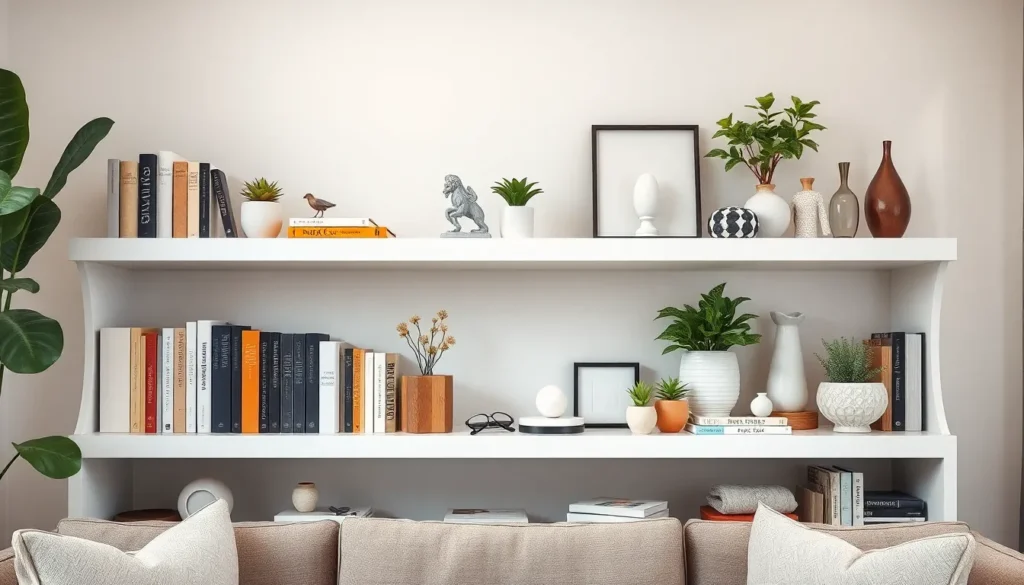We’ve all stared at those empty shelves in our living rooms wondering how to transform them from boring storage spaces into stunning design focal points. Whether you’re dealing with built-in bookcases floating shelves or entertainment centers these surfaces hold incredible potential to showcase your personality and elevate your entire room’s aesthetic.
The secret to beautiful shelf styling isn’t just about filling space—it’s about creating visual balance mixing textures and telling your unique story through carefully curated displays. From layering books and plants to incorporating meaningful artwork and decorative objects the possibilities are endless when you know the right techniques.
We’re here to share practical decorating ideas that’ll help you turn those blank shelves into magazine-worthy displays that guests will admire. These proven strategies work for any budget style or space size so you can create a living room that truly feels like home.
Create Visual Balance With the Rule of Thirds
We’ll transform your shelf displays by applying the classic rule of thirds, which divides visual space into three equal sections to create naturally pleasing arrangements. This fundamental design principle guides our eye movement and creates harmony in any living room display.
Group Items in Odd Numbers
Grouping decorative objects in sets of three, five, or seven creates visual interest that draws attention naturally. We find that odd numbered arrangements feel more ever-changing and captivating than even groups, which can appear static or forced.
Three coordinated vases of different heights work beautifully on a single shelf section. Mix ceramic, glass, and metal finishes to add texture while maintaining cohesion through similar colors or shapes.
Five small succulent plants in matching pots create a fresh, organic display. Space them with varying gaps between each plant to avoid creating a rigid line that feels too formal for comfortable living spaces.
Seven framed family photos in coordinating frames tell a story across your shelf. Alternate between portrait and industry orientations to create visual rhythm that keeps viewers engaged with your personal collection.
Vary Heights and Shapes
Different heights create visual layers that add depth and dimension to flat shelf surfaces. We stack books horizontally to create platforms for smaller objects, immediately adding multiple levels to work with.
Tall candlesticks paired with low decorative bowls establish clear height contrast. Choose pieces that complement each other in color or material while serving different visual purposes in your arrangement.
Round objects soften the hard edges of rectangular books and picture frames. Ceramic spheres, woven baskets, or circular mirrors break up angular shapes and create visual relief in structured displays.
Triangular arrangements using items of short, medium, and tall heights guide the eye smoothly across your shelves. Position your tallest piece at one end, medium height in the center, and shortest item at the opposite end for natural flow.
Leave Strategic White Space
Empty space between grouped items prevents your shelves from looking cluttered or overwhelming. We recommend leaving at least 25-30% of your shelf space undecorated to let each carefully chosen piece breathe and shine.
Negative space acts as a visual rest stop that helps define separate vignettes on longer shelves. Create distinct zones by leaving 6-8 inches between different groupings of decorative objects.
Breathing room around taller items like lamps or large vases emphasizes their importance in your display. Surround statement pieces with generous space to establish them as focal points rather than part of busy arrangements.
Strategic gaps between books and objects create opportunities for the eye to pause and appreciate individual elements. This intentional spacing transforms random collections into thoughtfully curated displays that feel professionally styled.
Layer Books Horizontally and Vertically
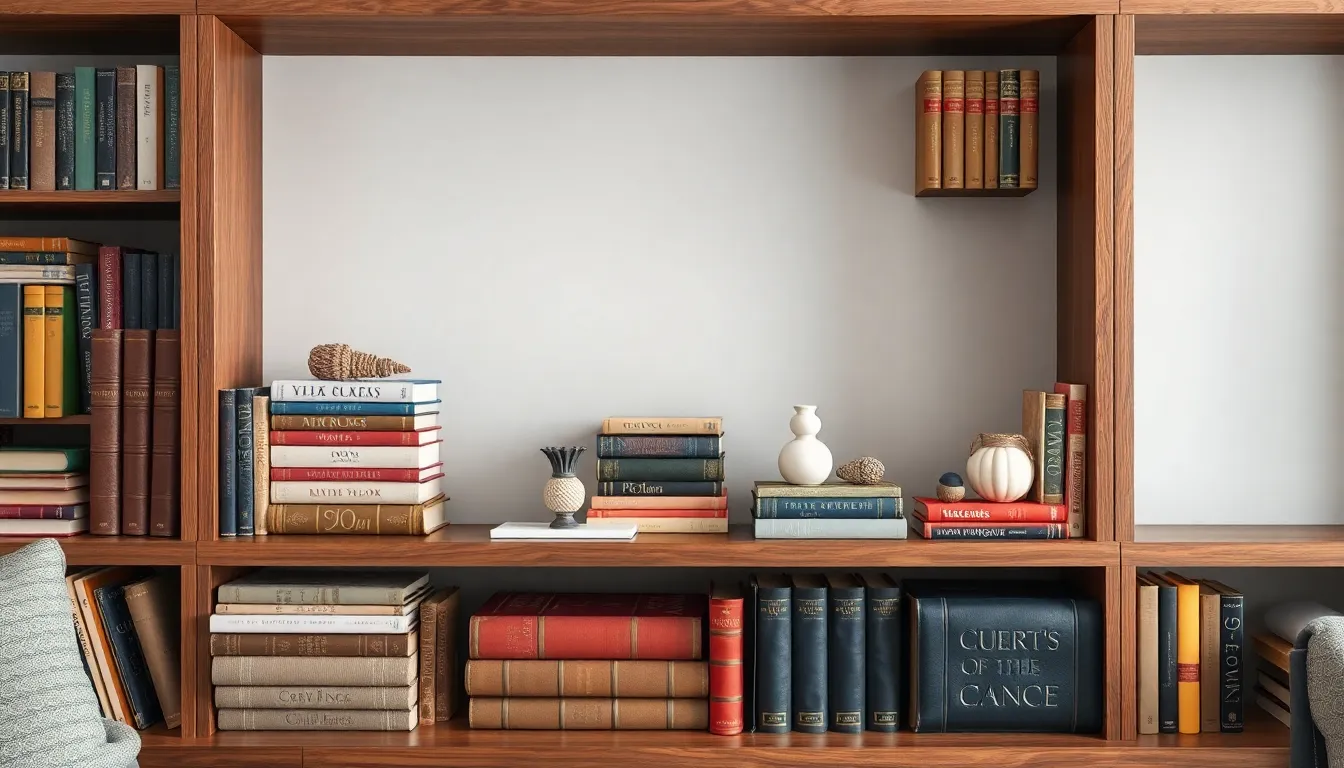
Book arrangement transforms ordinary shelves into ever-changing focal points that capture attention and create visual depth. We’ve discovered that mixing horizontal and vertical positioning creates the foundation for sophisticated shelf styling.
Stack Books as Pedestals for Decor
Horizontal book stacks serve as elevated platforms that showcase our favorite decorative pieces with greater impact. We place 3-5 books flat on their sides to create stable pedestals for vases, sculptures, or small art pieces. This technique adds multiple layers to our displays while maximizing vertical space usage.
Small decorative objects gain prominence when positioned atop book pedestals rather than sitting directly on shelf surfaces. We select books with similar spine heights to create uniform pedestals, or we intentionally vary the stack heights to establish rhythm across the entire shelf. Picture frames, candles, and collectibles become conversation starters when elevated on these literary foundations.
Display Colorful Spines as Art
Book spines create vibrant art installations when we arrange them by color gradients or complementary hues. We group titles with similar spine colors together to form rainbow displays that serve as striking visual anchors within our living rooms. This approach works exceptionally well with vintage titles featuring bold typography or modern books with eye-catching cover designs.
Color coordination transforms book collections into cohesive design elements that complement our existing decor palette. We arrange warm tones like reds, oranges, and yellows on one section while placing cool blues, greens, and purples in another area. Neutral colored spines in whites, grays, and blacks provide visual breaks between more saturated color groupings.
Mix Vintage and Modern Titles
Combining old and new books creates compelling visual contrast that tells the story of literary evolution over time. We intersperse leather-bound classics with contemporary paperbacks to establish an eclectic aesthetic that feels both scholarly and current. Vintage books with weathered spines add character and history to our displays.
Modern titles contribute fresh energy to collections dominated by older volumes, while antique books lend gravitas to shelves filled with newer publications. We balance these elements by ensuring neither vintage nor contemporary titles overwhelm the other, creating harmonious arrangements that celebrate both literary eras equally.
Incorporate Natural Elements and Greenery
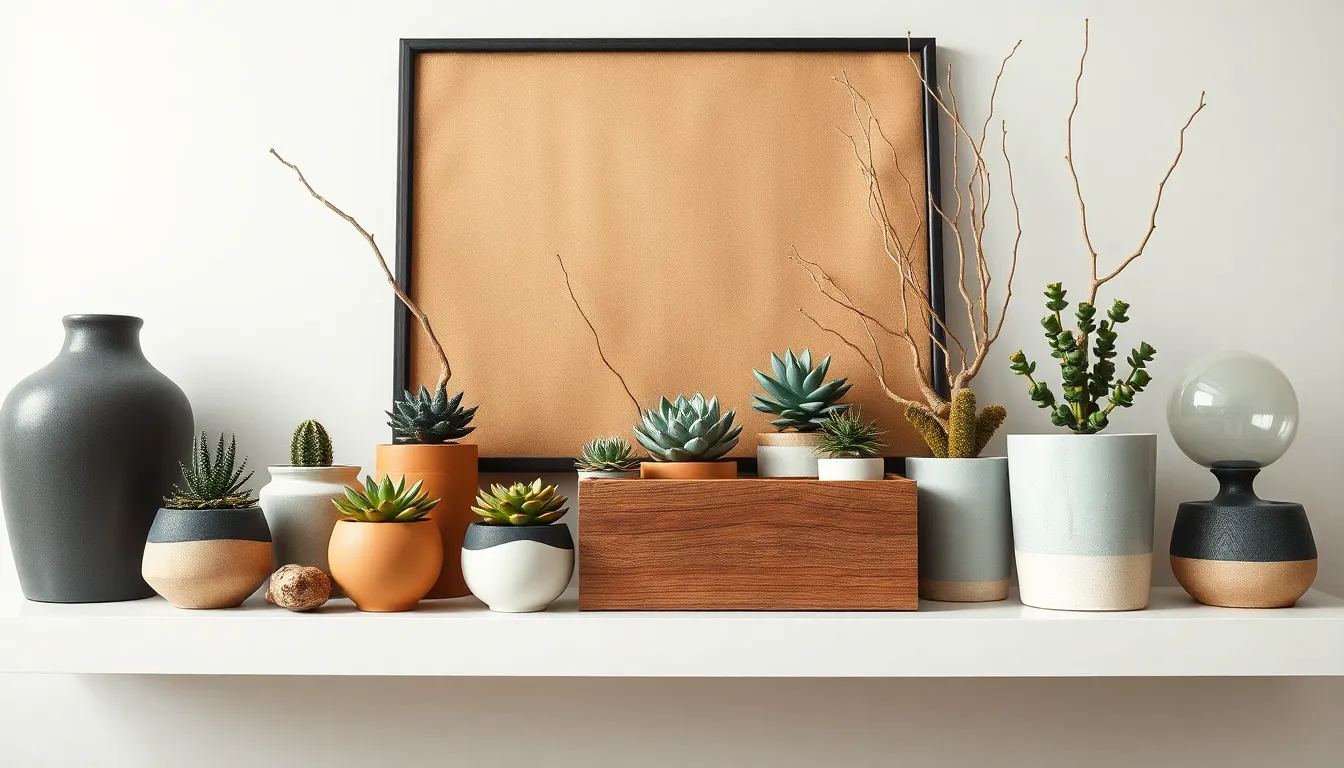
Natural elements bring life and organic beauty to our shelf displays, creating a refreshing contrast to harder decorative pieces. We can transform sterile shelving into vibrant, living spaces that connect our interiors with the outdoors.
Add Small Potted Plants or Succulents
Small potted plants transform empty shelves into living galleries that breathe fresh energy into our living rooms. Succulents offer the perfect solution for busy homeowners since they require minimal maintenance while providing maximum visual impact through their variety of shapes and sizes. We can choose from trailing varieties like string of pearls for cascading effects, or compact rosettes like echeveria for structured displays.
Potted herbs like basil or mint serve dual purposes by adding greenery while providing fresh ingredients for cooking. Placing these plants at different heights creates natural layers that complement our other decorative elements. Small ceramic or terracotta pots enhance the organic aesthetic while offering neutral tones that blend seamlessly with existing decor.
Include Dried Branches or Pampas Grass
Dried branches create stunning natural centerpieces that add rustic charm and architectural interest to our shelves. Pampas grass brings texture and movement through its feathery plumes, creating soft contrast against harder surfaces like books or picture frames. We can arrange these elements in tall vases or simply lean them against the back of our shelves for casual, effortless styling.
Birch branches offer clean lines and neutral colors that work with any decor style, while eucalyptus branches provide subtle fragrance alongside their silvery green foliage. These dried elements require zero maintenance yet deliver maximum impact, making them ideal for high shelves or hard to reach areas. Pairing them with ceramic vessels or glass containers creates sophisticated vignettes that feel both natural and curated.
Use Natural Wood or Stone Accents
Natural wood accents introduce warmth and texture that softens the linear nature of shelving systems. Wooden decorative boxes provide both storage answers and visual interest while maintaining our organic theme throughout the display. We can incorporate different wood tones to create depth, mixing lighter woods like pine with darker options like walnut for contrast.
Stone vases and sculptures add weight and grounding elements that balance lighter items on our shelves. These materials provide earthy ambiance that makes our living spaces feel more connected to nature’s textures and colors. Smooth river rocks or textured limestone pieces create focal points that draw the eye while complementing both modern and traditional decor styles.
Display Personal Collections and Treasures
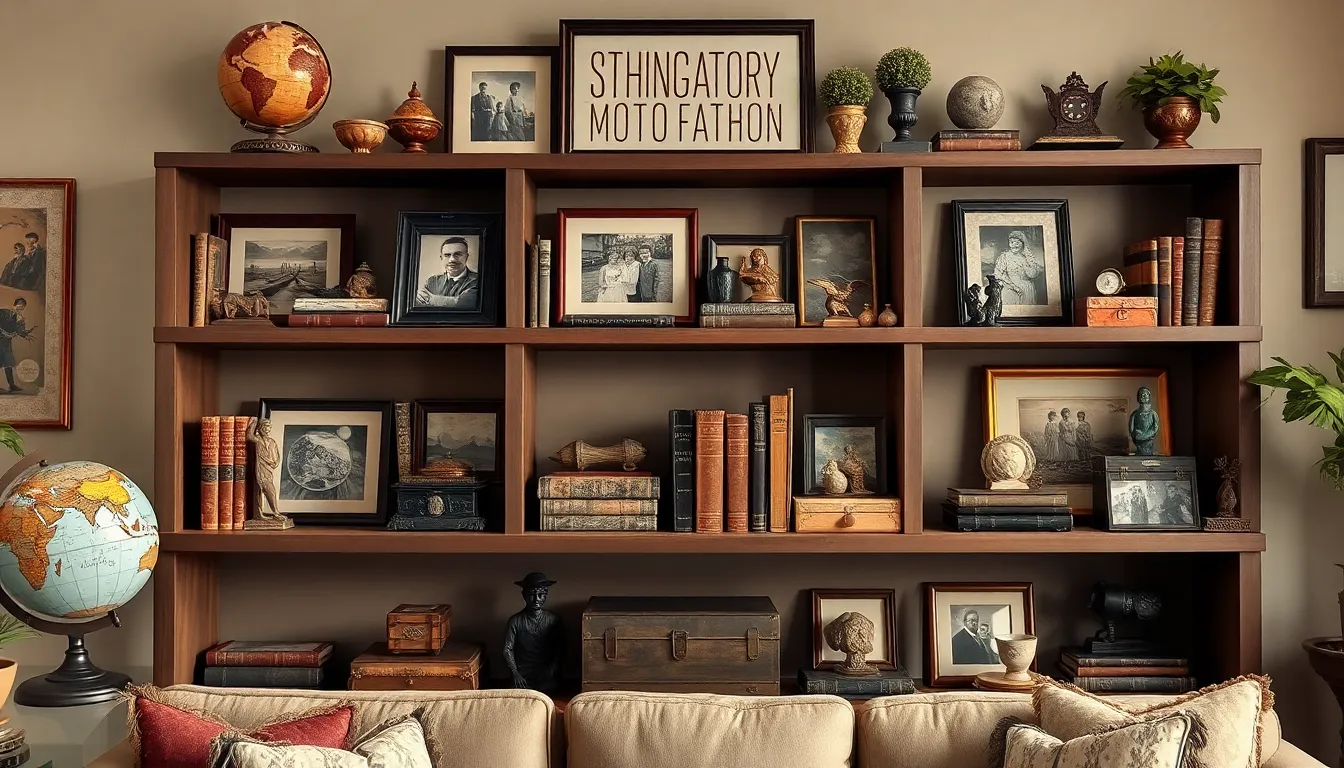
Personal collections transform ordinary shelves into meaningful displays that tell our unique stories. We can create captivating vignettes by incorporating decorative boxes, sculptures, and heirloom pieces that reflect our individual personalities and experiences.
Showcase Travel Souvenirs and Memorabilia
Travel souvenirs become conversation starters when we strategically place vintage maps, globes, and cultural artifacts throughout our shelf arrangements. Layering smaller items in front of larger ones creates visual depth that draws the eye naturally across the display. We should group these treasures using the rule of thirds, arranging them in odd numbers for optimal balance and visual appeal.
Miniature landmarks, traditional textiles, and local pottery from different countries add authentic character to our living spaces. Currency collections, postcards, and handcrafted jewelry from various destinations create interesting focal points when displayed in shadow boxes or glass cases. We can enhance these displays by incorporating geographic elements like compass roses or antique navigation tools that complement our travel theme.
Arrange Vintage Finds or Antiques
Vintage items like old clocks, ceramic vases, and framed botanical prints bring timeless elegance to our shelf styling. Mixing textures and shapes keeps these displays visually interesting while maintaining a cohesive aesthetic throughout the room. We should balance ornate pieces with simpler forms to prevent overwhelming the space.
Antique books with weathered spines create beautiful backdrops for smaller decorative objects when stacked horizontally. Brass candlesticks, vintage cameras, and old typewriters serve as striking centerpieces that anchor our arrangements. Incorporating family heirlooms like grandmother’s china or grandfather’s pocket watch adds emotional depth to our displays while preserving precious memories.
Feature Family Photos in Stylish Frames
Family photographs become artistic elements when we use a variety of frame styles and sizes throughout our shelf arrangements. Placing photos in front of decorative backgrounds or objects enhances the overall display while creating layered visual interest. We can mix metal, wood, and acrylic frames to add texture diversity to our collections.
Black and white portraits paired with colorful contemporary frames create striking contrasts that elevate our personal gallery walls. Vintage family photos in ornate gilded frames complement antique decorative pieces beautifully. We should vary the orientation and positioning of framed photographs, leaning some against books while placing others on small easels for ever-changing presentation.
Add Ambient Lighting for Warmth
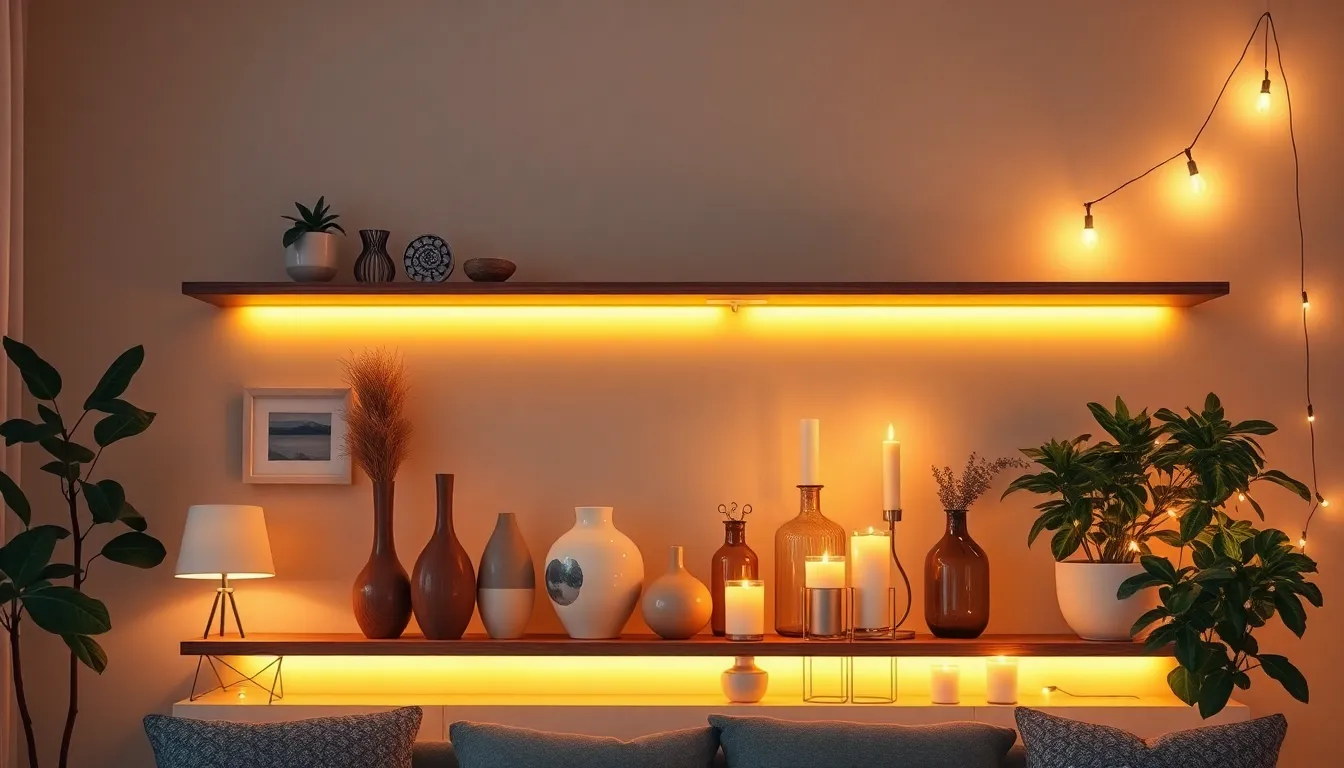
Strategic lighting transforms shelf displays from static arrangements into ever-changing focal points that draw the eye and create inviting atmospheres. We’ll explore three effective lighting techniques that enhance your carefully curated collections while adding warmth to your living room space.
Install LED Strip Lights Behind Shelves
LED strip lights create modern and sleek glows that illuminate your displays without overwhelming them. Installing these versatile lights behind shelves produces gentle backlighting that highlights silhouettes and adds depth to your arrangements. We recommend choosing warm white LED strips (2700K-3000K) to maintain the cozy atmosphere you’ve worked to create through your decorative choices.
Positioning these strips along the back edges of shelves ensures even light distribution across your displayed items. Most LED strips come with adhesive backing that makes installation straightforward and damage-free. Battery-powered options eliminate the need for electrical work while remote controls allow you to adjust brightness levels throughout the day.
Place Small Table Lamps or Candles
Small table lamps and candles add warmth and coziness to your shelf displays while serving as decorative elements themselves. Compact table lamps work particularly well on deeper shelves where they won’t interfere with your other decorative arrangements. Choose lamps with interesting bases that complement your existing decor theme and textural mix.
Candles bring flickering warmth that creates intimate ambiance during evening hours. We suggest using battery-operated candles for safety while maintaining the cozy effect of real flames. Varying candle heights and grouping them in odd numbers follows the same rule of thirds principle we’ve discussed for other decorative elements.
Pillar candles on small decorative plates create elegant focal points that can anchor your shelf arrangements. Tea lights in attractive holders add subtle sparkle without competing with your larger display pieces.
Use String Lights for Cozy Atmosphere
String lights create magical atmospheres by wrapping around decorative items or along shelf edges for dreamy illumination. These flexible lighting answers work especially well with natural elements like dried branches or trailing plants you’ve incorporated into your displays. Micro LED string lights offer delicate sparkle that enhances your collections without creating harsh shadows.
Draping string lights behind translucent objects like glass vases or ceramic pieces creates beautiful silhouettes and soft color variations. We recommend warm white or soft yellow string lights that complement the cozy living room environment you’re creating. Timer functions allow these lights to automatically create ambiance during your preferred evening hours.
Battery-powered string lights eliminate cord management issues while offering placement flexibility throughout your shelf arrangements. Choose lights with thin, nearly invisible wires that won’t detract from your carefully chosen decorative pieces.
Use Decorative Storage Baskets and Boxes

Decorative storage answers let us maintain our beautifully styled shelves while keeping everyday items organized and accessible. We can transform cluttered spaces into polished displays by choosing storage pieces that complement our living room’s aesthetic.
Hide Clutter in Stylish Woven Baskets
Woven baskets offer an elegant solution for concealing items like remote controls, magazines, and children’s toys without sacrificing style. We recommend selecting natural materials such as seagrass, rattan, or jute that add organic texture to our shelf displays. These baskets work particularly well when paired with plants and wooden accents, creating cohesive layers that feel intentional rather than cluttered.
Varying basket sizes creates visual interest while maximizing storage potential. We can place larger baskets on lower shelves for heavier items like blankets or board games, while smaller versions work perfectly for organizing mail, keys, or charging cables on upper levels. The natural weave patterns add subtle visual texture that complements both modern and traditional living room styles.
Choose Boxes That Match Your Color Scheme
Storage boxes become decorative elements when we select colors that harmonize with our existing palette. We suggest choosing boxes in neutral tones like cream, sage green, or soft gray for versatile styling that won’t compete with our displayed treasures. These cohesive colors help maintain the polished look we’ve established through careful shelf arrangement.
Monochromatic box collections create sleek, sophisticated displays that feel professionally curated. We can also introduce subtle pops of accent colors that echo other elements in our living room, such as throw pillow hues or artwork tones. This strategic color coordination ensures our storage answers enhance rather than disrupt the visual flow we’ve created.
Label Storage Containers for Organization
Labels transform functional storage into an organized system that maintains our shelf’s aesthetic appeal. We recommend using elegant label styles such as handwritten calligraphy tags, printed labels in coordinating fonts, or even small chalkboard labels for changeable organization. These finishing touches demonstrate attention to detail while keeping contents easily identifiable.
Clear labeling helps family members maintain our carefully arranged displays by returning items to their designated homes. We can create labels that match our living room’s style, whether that’s minimalist white labels for modern spaces or vintage inspired tags for traditional decor. This organizational system ensures our decorative storage answers remain both beautiful and functional over time.
Incorporate Artwork and Sculptural Pieces

Artwork and sculptural elements transform ordinary shelves into sophisticated gallery displays that showcase your personal aesthetic. We’ll explore three powerful techniques for incorporating artistic pieces that add visual weight and creative flair to your living room shelves.
Lean Small Framed Prints Against the Wall
Leaning small framed prints against the back wall creates an effortlessly curated look that feels both intentional and relaxed. Position these prints at varying heights behind your decorative objects to establish visual layers that draw the eye deeper into the display. Mix different frame sizes and orientations—combining 5×7 and 8×10 prints in both portrait and industry formats creates ever-changing visual interest.
Layer your prints by placing larger frames behind smaller ones, allowing portions of each piece to remain visible. This technique works particularly well when you rotate prints seasonally, giving your shelves a fresh perspective without major rearrangement. Choose artwork that complements your existing color palette while introducing subtle pops of contrast that energize the overall composition.
Display Ceramic or Metal Sculptures
Ceramic and metal sculptures serve as striking focal points that anchor your shelf arrangements with three-dimensional artistry. Select pieces with varying heights and textures—smooth ceramic vases paired with textured metal bowls create compelling contrasts that engage multiple senses. Position larger sculptural pieces at shelf ends or corners where they can command attention without overwhelming smaller decorative items.
Incorporate handcrafted pottery, blown glass pieces, or geometric metal forms that reflect your personal style and complement your living room’s existing materials. These sculptural elements work best when balanced with negative space, allowing each piece to breathe and maintain its individual impact. Consider the interplay between warm ceramic tones and cool metal finishes to create sophisticated material conversations throughout your display.
Add Decorative Mirrors for Depth
Decorative mirrors amplify both light and space while creating the illusion of expanded shelf depth that makes your living room feel larger and brighter. Place small mirrors behind or between decorative objects to reflect light from nearby windows or ambient lighting sources. This technique doubles the visual impact of your carefully arranged items while adding sparkle and movement to static displays.
Choose mirrors with interesting frames—vintage brass, modern geometric shapes, or ornate antique styles—that complement your overall decorating scheme. Position mirrors at slight angles to catch and redirect light in unexpected ways, creating ever-changing reflections that change throughout the day. The reflective surfaces also bounce colors and textures from surrounding objects, creating a cohesive visual echo that ties your entire shelf arrangement together.
Play With Color and Texture Combinations
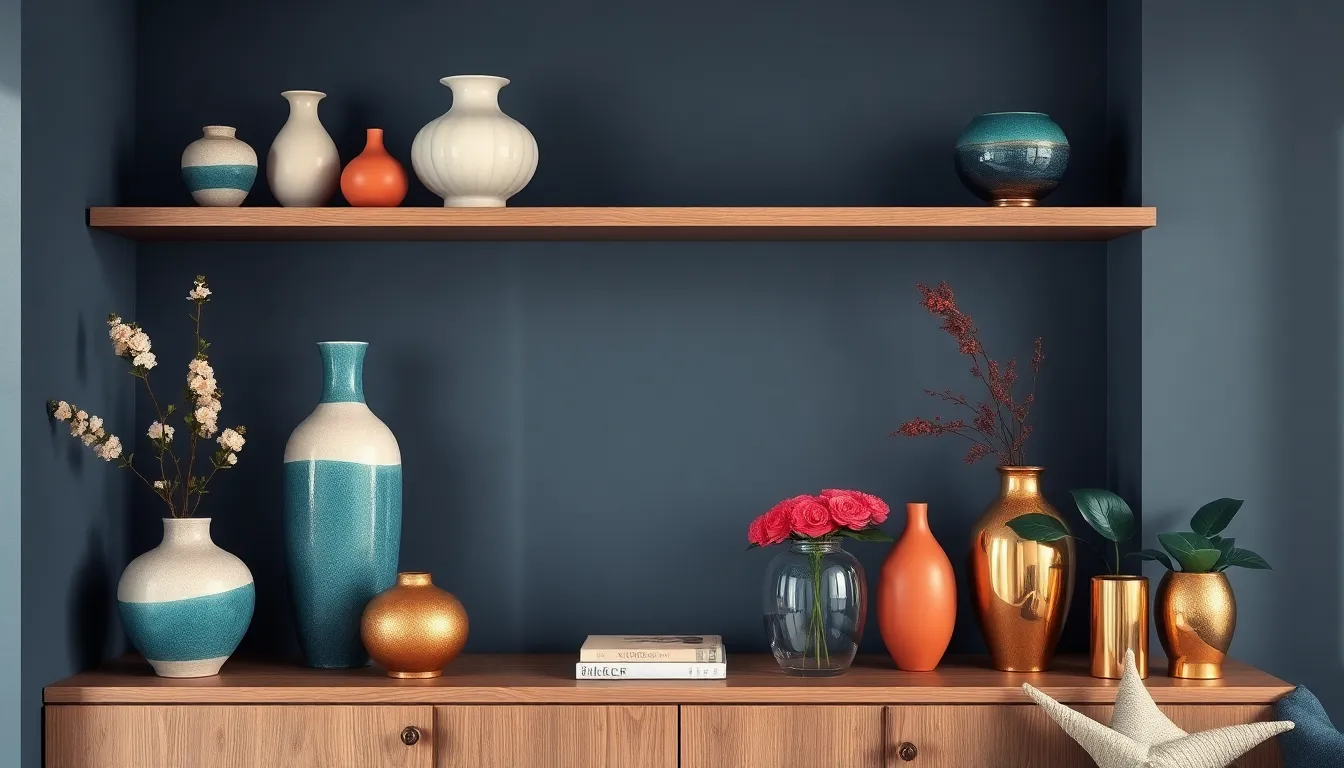
Color and texture combinations form the foundation of successful shelf styling. We’ll explore how strategic choices create visual harmony while adding depth and sophistication to your displays.
Create Cohesive Color Palettes
Monochromatic schemes deliver sleek, polished results that feel professionally curated. We recommend selecting one primary color and incorporating its various shades and tones throughout your display. Cream, white, and beige combinations create calming sophistication, while navy blues paired with lighter sky tones offer refined elegance.
Complementary color pops inject personality and energy into neutral foundations. Adding vibrant accent pieces like coral vases, emerald books, or golden picture frames creates focal points that draw the eye. We suggest limiting bright colors to 20-30% of your display to maintain balance.
Seasonal color rotations keep your shelves feeling fresh throughout the year. Warm oranges and deep reds work beautifully for autumn displays, while soft pastels and bright whites capture spring’s essence. This approach allows you to refresh your styling without completely reorganizing your arrangement.
Mix Smooth and Rough Textures
Ceramic and glass pieces provide smooth, reflective surfaces that catch and bounce light throughout your space. Glazed pottery, crystal vases, and polished decorative bowls create elegant contrast against rougher materials. We place these items strategically to maximize their light reflecting properties.
Wood and natural fiber elements introduce organic warmth and visual weight to your displays. Woven baskets, carved wooden sculptures, and bamboo picture frames add earthy texture that grounds more delicate pieces. Rough bark textures on decorative branches create particularly striking contrasts.
Metal accents bridge the gap between smooth and textured surfaces while adding structural interest. Hammered copper bowls, brushed steel picture frames, and wrought iron candle holders provide medium texture that complements both extremes. These pieces often serve as transitional elements in your arrangements.
Use Metallics for Glamorous Accents
Gold and brass accessories create luxurious focal points that elevate any shelf display. Picture frames, decorative boxes, and small sculptures in these warm metals add instant sophistication. We recommend using gold tones sparingly as accent pieces rather than dominant elements.
Silver and chrome pieces offer modern elegance that pairs beautifully with contemporary decor styles. Polished metal vases, sleek picture frames, and geometric sculptures in these cooler tones create striking visual interest. These metallics work particularly well in monochromatic color schemes.
Mixed metal combinations add complexity and visual richness when done thoughtfully. Pairing warm brass with cool silver creates ever-changing tension, while copper and gold tones complement each other naturally. We suggest maintaining a 70-30 ratio between your primary and secondary metal tones for balanced sophistication.
Style Floating Shelves for Modern Appeal
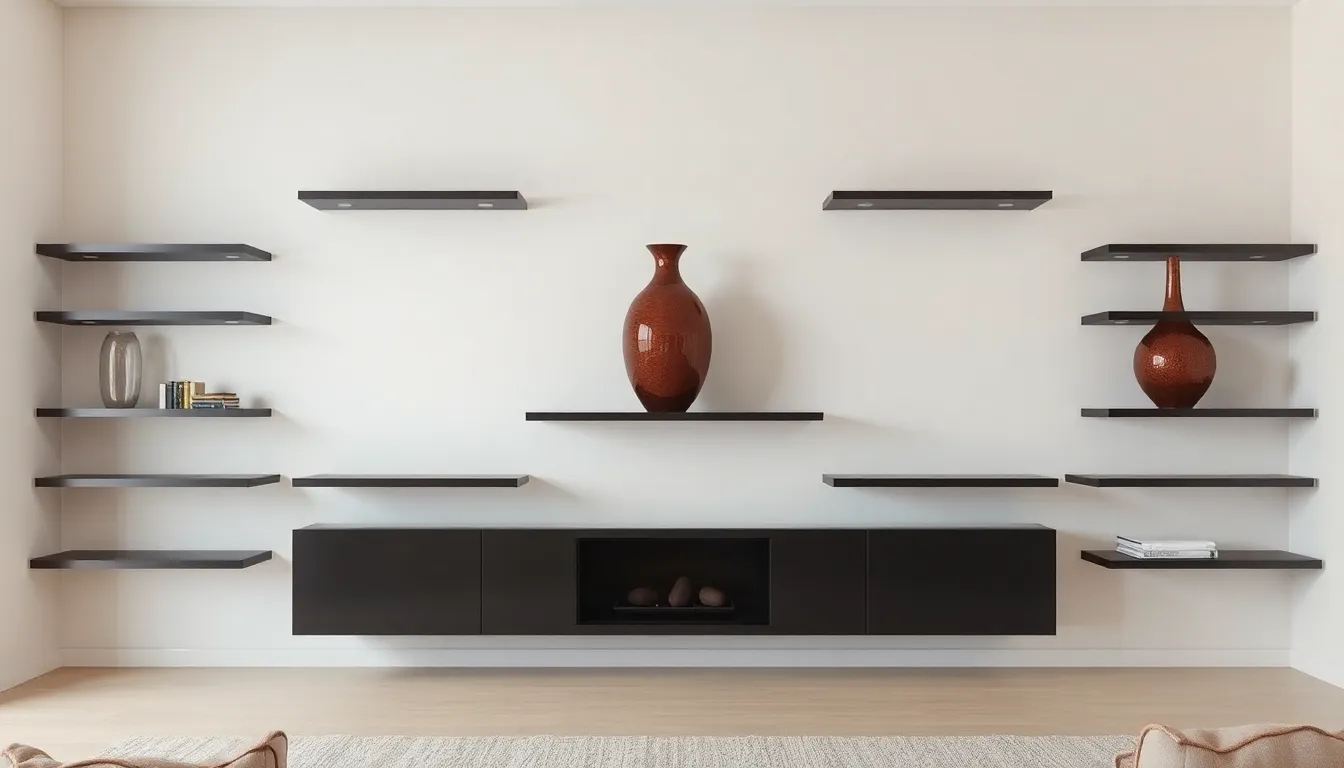
Floating shelves offer the perfect canvas for contemporary living room design, creating visual interest without overwhelming your space. These wall-mounted displays allow us to showcase our favorite pieces while maintaining the clean aesthetic that defines modern interior style.
Keep Lines Clean and Minimal
Modern floating shelves thrive on simplicity and uncluttered surfaces that let each piece breathe. We recommend choosing shelves with straight edges and smooth finishes to maintain that sleek contemporary look. Clean lines create visual calm in your living room, making the space feel more open and organized.
Visual clutter becomes the enemy of modern design, so we suggest limiting decorative elements to create maximum impact. Select shelves in neutral tones like white, black, or natural wood to complement your existing color palette. The beauty of minimal design lies in its ability to make every item on your shelf feel intentional and purposeful.
Focus on Fewer, Statement Pieces
Statement pieces command attention and define the character of your floating shelf display. We encourage selecting one or two large items rather than crowding shelves with multiple small decorations. A single oversized vase, sculptural piece, or large framed photograph can transform an entire wall into a focal point.
Large vases work exceptionally well as statement pieces because they provide height and visual weight to your arrangement. Unique sculptures or art pieces bring personality to your modern shelving while maintaining that sophisticated aesthetic. We’ve found that choosing items with interesting shapes or textures creates more visual interest than relying on color alone.
Balance becomes crucial when working with statement pieces on floating shelves. Position your largest item slightly off-center to create ever-changing visual flow across the shelf. This asymmetrical approach feels more natural and captivating than perfectly centered arrangements.
Maintain Consistent Spacing
Consistent spacing creates the foundation for professional-looking floating shelf displays in modern living rooms. We recommend measuring equal distances between shelves and maintaining the same gap between decorative items. This systematic approach ensures your shelving looks intentional rather than haphazard.
Even spacing between items allows each piece to stand out while contributing to the overall composition. Leave approximately 4-6 inches between decorative objects to prevent crowding and maintain visual clarity. The eye needs these breathing spaces to appreciate each element in your display.
Visual flow improves dramatically when we maintain consistent spacing throughout our floating shelf arrangement. Consider the vertical spacing between multiple shelves as well, keeping them evenly distributed to create a cohesive wall display. This attention to spacing details elevates your shelving from casual decoration to sophisticated design element.
Conclusion
Transforming your living room shelves from empty spaces into stunning focal points doesn’t require a complete redesign or massive budget. We’ve shown you that with the right balance of personal treasures natural elements strategic lighting and thoughtful color coordination you can create displays that rival any professional design.
Remember that great shelf styling is about telling your story while maintaining visual harmony. Whether you’re working with floating shelves or traditional bookcases the key lies in mixing textures varying heights and leaving enough breathing room for each piece to shine.
Start with one shelf and experiment with these techniques. You’ll be amazed at how quickly your living room transforms into a space that truly reflects your personality and style.
Frequently Asked Questions
What is the rule of thirds in shelf styling?
The rule of thirds divides your shelf space into three equal visual sections to create harmony and balance. This classic design principle helps you arrange items in a way that feels naturally pleasing to the eye, preventing overcrowded or unbalanced displays.
How much of my shelf space should remain empty?
Leave 25-30% of your shelf space undecorated to prevent clutter and allow each piece to stand out. This strategic use of white space creates breathing room between items and makes your display look intentional rather than overcrowded.
Should I group items in even or odd numbers?
Group items in odd numbers (three, five, or seven) to create dynamic visual interest. Odd-numbered groupings naturally feel more balanced and engaging to the eye than even-numbered arrangements, which can appear too symmetrical and static.
How do I mix books with decorative items effectively?
Layer books both horizontally and vertically to create depth, using horizontal book stacks as pedestals for decorative objects. Arrange colorful book spines in gradients or complementary colors, and mix vintage and modern titles to create visual contrast and narrative interest.
What natural elements work best for shelf displays?
Small potted plants like succulents and herbs require minimal maintenance while adding life to your shelves. Dried branches, pampas grass, and natural wood or stone accents introduce organic textures and warmth, creating sophisticated focal points that connect your space with nature.
How do I display personal collections without creating clutter?
Use the rule of thirds for balance and layer items at different heights to create visual depth. Incorporate decorative boxes to organize smaller pieces, and mix personal treasures with neutral elements to prevent overwhelming the display while maintaining your unique story.
What lighting techniques enhance shelf displays?
Install LED strip lights behind shelves for gentle backlighting, add small table lamps or candles for warmth, and use string lights for magical ambiance. Choose warm lighting tones to create a cozy atmosphere and highlight your displayed items effectively.
How do storage baskets improve shelf organization?
Woven baskets made from natural materials like seagrass or rattan conceal everyday items while adding texture. Vary basket sizes for visual interest, choose colors that match your room’s scheme, and consider elegant labeling to maintain both beauty and functionality.
What’s the best way to incorporate artwork on shelves?
Lean small framed prints against the wall for a curated gallery look, display ceramic or metal sculptures for visual weight, and add decorative mirrors to create depth and amplify light. These artistic elements reflect personal style while creating sophisticated focal points.
How do I create cohesive color schemes for my shelves?
Develop monochromatic schemes for a polished look or incorporate vibrant accent pieces for personality. Rotate seasonal colors to keep displays fresh, and balance smooth and rough textures with metallic accents to add glamour and visual richness to your arrangement.

